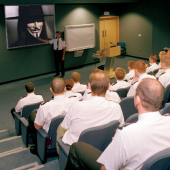Technology killing off the traditional lecture?


Some lecturers provide their content over webcams and VoIP to students, who can lie in bed with a cigarette and a can of Carlsberg at 9am in the morning (it happens, talking about my own experiences). You can write messages to your lecturer with questions, you can download the session again for later use, and study when you like. To be fair, this works well for the lecturers too, as they can dress from the top half of the desk and everybody watching is none-the-wiser.
The majority don't. Lectures are given in theatres, packed full of students, scribbling away notes trying to keep up with the pace of a bumbling old-aged professor. You can stick your hand up, ask a question, speak to them afterwards and get more out of the lecturer; after all, this is what university is all about, taking advantage of the resources available, considering you're paying enough for it.
These lectures are often recorded, screencasted and put up on a VLE for others to view and read, listen and learn. Considering these are one-sided and "read only", you can't interact with a recorded lecture. I asked Bryant Zadegan, an old friend of mine over at AeroXP, who studies in Virginia agreed with me:
"The problem with pre-recorded screencasts of lectures, besides not being able to ask questions during the lecture, is that it's much easier to absorb material when a person is in the mindset of learning. A student would be more likely to not actively pay attention to the material in a screencast... which would mean less material is picked up."
We learn by asking questions, and if we can't ask questions, we don't learn. Should a VLE be used as the single point of knowledge or as a replacement for lectures? Or should a VLE be used to complement the learning process and nothing more? Let me know what you think - this could be an interesting one.